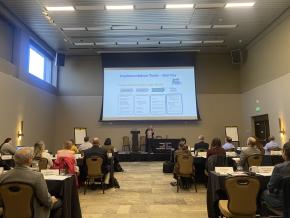
Trauma is pervasive throughout the criminal legal system. Courts have the power to break the cycle of harm.
Our understanding of trauma—both in research institutions and in our culture as a whole—has evolved a great deal in recent years. Compared to just a few decades ago, we are much more likely to understand today that a traumatic event can influence how we feel, think, and act long after we are removed from danger. Trauma can make us feel scared, angry, or alienated from others; it can make us hyper-aware of potential threats; and, in some cases, it can even impair our ability to regulate our emotions and make safe, thoughtful decisions.
Awareness of trauma has also grown in the criminal legal system, where traumatic experiences are rampant among survivors, witnesses, and people who have been arrested. As common as traumatic experiences are in the general population, they are even more common among people—both kids and adults—involved in the legal system. According to one study of jail diversion programs, 96 percent of women and 89 percent of men participating had experienced trauma. Trauma is especially prevalent among women in the system, who are much more likely to be arrested in relation to experiences with sex trafficking or domestic violence.
Actual practices in the criminal legal system, though, don’t always keep pace with our understanding. Apart from the wide-ranging harms of jail and prison, the legal process itself can be scary and traumatizing even when it doesn’t end in a serious sentence. Large, confusing court buildings; intimidating legal procedures; interactions that are often cold and adversarial—all of these can inflict more harm on people who have already experienced trauma. And since traumatic experiences are linked to higher odds of legal involvement, a court system that adds to people’s trauma only fuels the cycle of harm.
What would it mean for courts to take trauma seriously? That was the focus of a recent symposium our Office of National Initiatives team hosted with support from the State Justice Institute, bringing together practitioners from around the country to share their experiences responding to trauma in the legal system. Among the attendees were experts from Trauma Informed Oregon, which promotes better responses to trauma across institutions, and the DLR Group, an architectural firm with experience redesigning court spaces to make them less intimidating and more welcoming to those in them.

30 attorneys, judges, tribal counselors, and other practitioners convened in Denver, Colorado over the two days of the Symposium to learn from each other's experiences with trauma-informed practices.
The discussion centered on how courts, and the people who work in them, can be mindful of how trauma affects people in the legal system and avoid further harming those who have already been hurt. Instead of rehashing violent or painful experiences, for example, practitioners can limit the number of times someone is screened or assessed before receiving services. Courts can repurpose available spaces to make sure that people have somewhere they can collect their thoughts, feel a sense of privacy, or sit with their children before a hearing. And the experience of navigating the court building can be made less intimidating if staff are available to greet people, help them find their way, and answer any questions they may have when they arrive.
Even the physical design and layout of a court can make a world of difference in whether people feel safe as they navigate the legal process. Lowering the judge’s bench instead of having it tower over others in the room; bringing in natural light; keeping parking spaces and walkways well-lit; putting up readable, welcoming signage and warm artwork—all of these changes can help ensure that people do not have to experience more trauma during their time in court.
Trauma-informed practices like these have gained wider acceptance in special court programs that serve people with unique needs: drug treatment courts, mental health courts, veterans courts, and more. But progress has been slower in conventional criminal court settings, despite the evidence of widespread trauma among people who come into contact with the system. The symposium we hosted was a first step towards reckoning with trauma in the court system as a whole—not just those settings where trauma is often most apparent.
Trauma isn’t just present in a few unique or exceptional cases: it’s a pervasive theme running through our entire criminal legal system. By recognizing that trauma and actively accommodating people who have experienced it, our courts have the potential to break cycles of harm in people’s lives and in our communities.

